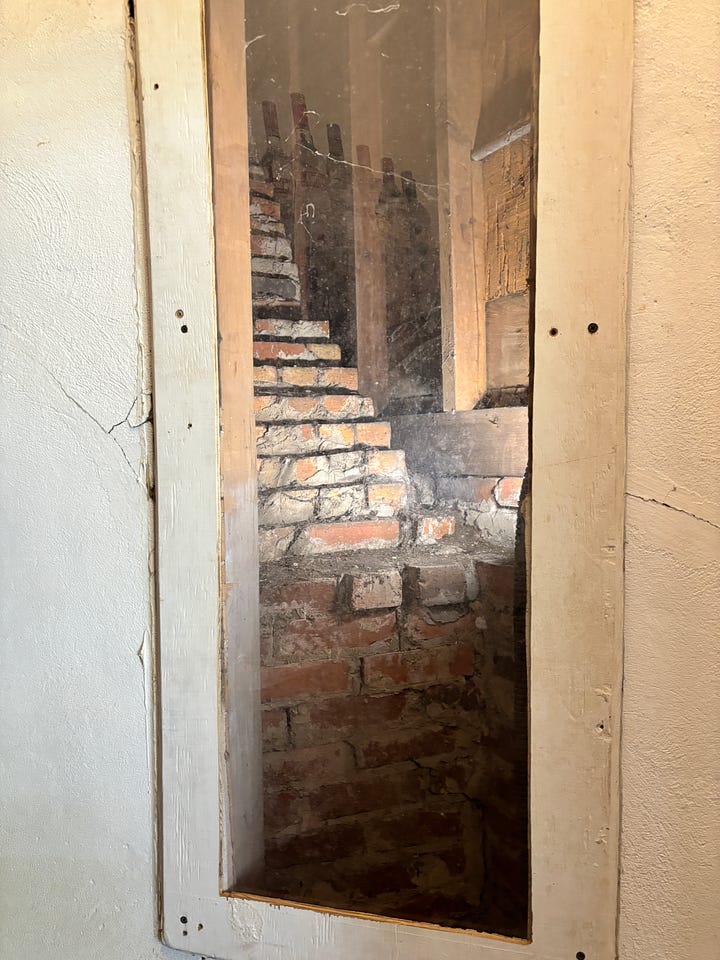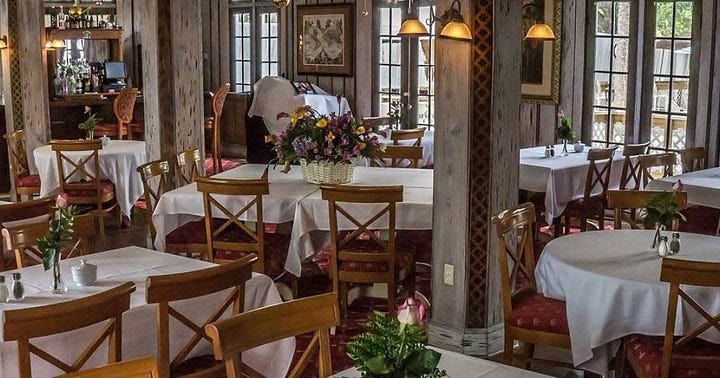Putnam Lodge: Historic Hotel in Old Florida
A microhistory about a Florida lumber town in Shamrock & Cross City
By Jason Phillips
This story is one new way we are broadening our scope at OH to tell more histories about neighborhood places that are meaningful to locals, and have deep roots in their communities. We are calling these “micro-histories.” Our OH travel writer, Jason Phillips, is a resident of the neighboring area in Florida, and wanted to share with readers more about his home region — a reminder that you don’t have to look far to find obscure histories around you. This post was scheduled long before Hurricanes Helene and Milton tore through the area. Jason’s nearby town was flattened, but the general area, and Putnam Lodge, are still ok. Please keep them in your thoughts. Goes to show that OH stories are written by real people, who are bringing you stories they think are important.
We are also delighted to debut a new feature with this story, a travelogue video shot and narrated by Jason Phillips showcasing the Putnam Lodge. See it below!
The historic Putnam Lodge is in the small company town of Shamrock, Florida, though the area is widely known as Cross City, the name of the neighboring town. Built in 1924-25, the hotel has a multifaceted history that spans the Northwest Florida timber industry, Native Americans, and locals will tell you it was a bootlegger hub for mobsters like Al Capone during prohibition. The timber connection stems from the original iteration of the lodge being a gentlemen’s club for timber executives and the use of virtually extinct pecky cypress to build it.
When the Putnam Lumber Company moved to the area in the early 1920s, William O’Brien, the president, decided to make this part of Dixie County a company town. He paid his employees well, built a school and commissary, and furnished nice homes for the workers. He named the town Shamrock as a nod to his Irish ancestry. He had a gentlemen’s club and upscale restaurant built and named it after his associate, E.B. Putnam.
By all measures, the Putnam Lumber Company was successful, and the company continues today with three locations and is one of the most successful in the United States. Along with providing education and lodging opportunities, the lumber mill also claimed the largest icehouse in the southeast United States. The lumber mill, and the Putnam Lodge, was built at the crossroads where the neighboring town got its name, Cross City. To this day, Putnam Lodge stands at the intersection where the Old Spanish Trail and the Old Salt Road meet.
The towns of Shamrock and Cross City are in Dixie County, a small county that was founded in 1921, primarily for the timber industry. Because of the timber industry, the population ballooned from 1,500 in 1921 to just over 6,000 within 15 years. Though the area is still involved in the lumber community today for yellow pine, pecky cypress is what brought Putnam Lumber to the area. It was desirable for its strength and beautiful peck marks caused by Stereum taxodii.
Pecky cypress is a special type of bald or swamp cypress that is caused by Stereum taxodii, a fungus in the soft tissue of over-mature trees. The fungus creates holes or tubes that run vertically throughout the tree, giving it a unique appearance. This, in a way, petrifies the tree and makes it very durable and provides a beautiful aesthetic. However, this does not occur until the tree is at least 125 years old and most of the trees have already been harvested. This is why pecky cypress is so rare and expensive today.
The contractor who designed and built the lodge, Edward Ball, had an ingenious idea for the construction. The popular financier and international traveler also constructed the Lodge at Wakulla Springs in 1937. He imported marble and tile to create the most ornate lodge of the era, similar to the Putnam Lodge.
Mr. Ball built the floor off the ground to allow airflow and installed louver windows over all the doors and transoms above the windows. This allowed for a constant breeze throughout the 36-room lodge to combat the swampy Florida heat. He also constructed the ornate lobby beams using pecky cypress. Native Americans painted the beams with mulberry juice, and O’Brien had shamrocks inlaid in the overhead cross beams.
While the connection between the Putnam Lodge and Al Capone isn’t as substantial as a historian could hope, there is evidence to suggest that some of its features were constructed in order to elude Prohibition authorities. Prohibition lasted from 1920-1933, and the Putnam Lodge would have been built during that time (1924-25). The evidence for it being a place for bootleggers is there if you know where to look. For example, there is a trap door in the lobby discreetly hidden under an Oriental rug leading to the crawl space beneath the hotel that would have provided a quick getaway. The mantle over the fireplace has a discrete peephole that looks into a small closet. The bootleg liquor was stashed in the closet and the bootleggers could view anyone who was trying to purchase their wares. The open-space upper floor served as a lookout point and gave a bird’s eye view to the illegal liquor still across the road.




The lodge has had several owners, though the information is hard to find because of its age. A married couple, the Browns, owned the lodge in the 1950s and converted it to a hotel when the town population grew to over 3,000. An article published in 1953 mentions that H.C Brown was once the comptroller for the Putnam Firm before he purchased the property.
Putnam Lodge served as a boarding house for school teachers in the 1970s because of its proximity to the local elementary school. School teachers would live in the hotel, sometimes for years, and would walk to the school every morning and grade their school papers in the lobby. One such teacher, Mary Miller, revisited the hotel in her 80s so she could reminisce about her past. The staff at the Putnam Lodge accommodated her stay, including a lobster dinner and lodging for the night. Mary’s old room is now called the Mary Miller room and is available for guests to book.
The current owners, Edward and Beverly Pivacek, have been in love with the Putnam Lodge since they first saw it in 1993. Ed, a former contractor has a keen eye for remodeling details while Beverly saw the potential for this being a world class hotel. They took the plunge in 2014 and have skillfully remodeled the vintage lodge into the hotel of their dreams, including a fine dining restaurant, aptly named “1927.”


The hotel has held up remarkably well due to the petrified pecky cypress, which is stronger than concrete over time. In fact, when the Pivaceks built the new kitchen for their restaurant, they had to build a wall in front of the existing one because no screws or nails would puncture the existing material. The fine dining steakhouse is to the left of the hotel lobby. The atmosphere is classy with a semi-dark interior while the exterior, set in a glass Florida room, is dressed in white to enhance the natural lighting that shines through. The owners have put a lot of love and care into the guest experience and pulled no stops when it comes to the 1927 steakhouse.
Guests are allowed to roam the 18-acre grounds and there is much wonder to behold. Peacocks roam freely around the grounds, and it is not uncommon to have one greet the guests as they walk out of the hotel. When guests walk out of one of the back doors to the manicured lawn, the first thing they see is a swimming pool with a black and white harlequin pattern on the deck. The property is tranquil and includes an aviary, rose garden, and a Japanese garden. The eloquent property reminds one of a past era in what is commonly referred to as “old Florida.”
Walking into the Putnam Lodge is an elegant way of returning to the past, and the hotel owners and employees are more than happy to regale you with the nuanced history of the Putnam Lodge. They also enjoy hearing about their guests’ stories and journeys too, which adds a level of comfort and southern charm to the hotel’s ambiance. The hotel is almost a century old and, although as sturdy as the day it was built, there have been modern changes made, though they do not detract from the original design of the Putnam Lodge.
Jason Phillips is a travel journalist and food writer based in Florida. When not on the road seeking unique and little-known destinations, he is usually crafting recipes in the kitchen. Enormous thanks to Putnam Lodge owners, Edward and Beverly Pivacek, for their time, stories, and delicious steak.
References
Secondary sources about the area.
https://myfwc.com/viewing/explore/historic-towns/
https://genealogytrails.com/fla/dixie/dixie_history.html
https://www.naturalnorthflorida.com/blog/a-closer-look-at-cross-citys-historic-putnam-lodge/
William O’Brien Obituary: https://www.findagrave.com/memorial/233168770/william_o&
Putnam Lumber Co.: https://www.putnamlumber.com/company.html
Pecky Cypress information:
Prohibition





